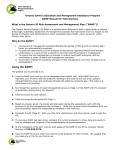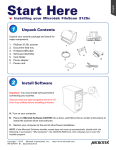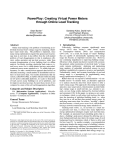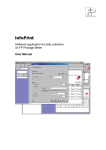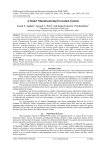Download A Study for Remedial Measures of Improper Temperature
Transcript
International Journal of Scientific Engineering and Research (IJSER) www.ijser.in ISSN (Online): 2347-3878 Volume 2 Issue 6, June 2014 A Study for Remedial Measures of Improper Temperature Indication System Used in IC Engines to Minimize Engine Losses Sunil Anand1, Amit Kumar Marwah2 1 Mechanical Engineering Department, Ujjain Engineering College, Ujjain, India 2 Mechanical Engineering Department, MIT, Ujjain, India Abstract: The study is based on the proper maintenance and working of I.C engine used in passenger cars. During the study of car cooling system, it is found that due to improper temperature indication system adopted in passenger car in India, there will be overheating in the engine, which leads to engine losses. Another major problem is that, overheating of engine is not detected quickly enough by the cooling system. The temperature meter shows the normal temperature of engine for fairly long duration, although the engine is overheated. Thus driver keeps on running the vehicle in overheated condition and could not judge the overheating merely by looking at temperature meter. The indication he gets regarding overheating are confusing and judgmental only. He has to judge the problem in cooling system on his own. And will run the engine for a quite period of time in heated condition which leads to engine loss. In today’s scenario, the design of any system is done keeping user friendliness in mind such that the working must be convenient and at the same time it must be design out maintenance ,which strives to eliminate or at least minimize the need of maintenance. This study focuses on present customer unfriendly temperature indication system and attempts to modify to reduce engine loss and lost engine life. For this the system is to be studied in detail and points of modification to reduce engine-losses are to be detected and suggested. Various steps are followed to achieve the above objectives like study of cooling system of I.C. engine of car, tracing of faults, methods of rectification of faults, suggestions for few modifications and feasibility test. The suggestions for modifications if followed will improve the engine life and hence make the system customers friendly. Keywords: Car, Cooling system, Engine losses, Overheating, Temperature indication 1. Introduction A common problem of engine overheating is being faced by the customer, which leads to heavy engine losses. Engine losses mean reduction in useful life of engine. Engine running with overheated condition is judged by the temperature indication system, equipped in cooling system. During a complaint of engine noise, it has being found that engine was running with very low level of coolant and engine is in overheated condition but still the temperature meter does not indicate overheating. This problem leads to generation of an idea which can rectify this problem. As the false indication are given by the temperature indication system some modification are needed in the cooling system. This study is done to propose a solution to the problem of overheating in passenger cars in India. The suggestions for modifications employed to car may lead to reduce engine losses as well as offer the end user a reduced maintenance effort. For this a complete study on car cooling system is done. This study is based on the practical problem faced during complaints made by the costumers regarding engine noise at a local car workshop. The complaint made by customer, when attended, found problem in coolant temperature indication system. Due to the problem mentioned, customer is not in a condition to judge the problem in cooling system and keeps on running the vehicle in condition of low coolant level. Engine running with low level of coolant leads to overheating of engine, which in turn, leads to engine losses. In order to understand the problem and to find solution to the problem the working of the cooling system is briefly explained and Paper ID: J2013297 then reason for the problem is traced out. Also suggestions are given on the possible rectifications, with the feasibility of solution suggested. The cooling system of one of the Hyundai car is studied and components of its cooling system are dismantled to get idea regarding the fault [1]. 2. Study of Cooling System of I.C. Engine of a Car Before actually coming to the problem let us first discuss about engine cooling system used in modern cars. The cooling system consists of radiator cap, radiator, coolant reservoir, hoses, water pump, cooling fan and thermostat [2]. The complete system is shown in Figure 1. Figure 1: Engine cooling system 1. Radiator inlet hose 5 Water pump 9 Radiator 2. Radiator outlet hose 6 IAC Valve 10 Oil cooler (A/T only) 3. Water intake pipe 7 Heater inlet hose 11 Engine 4. Thermostat 8 Heater outlet hose 12 ECT sensor Licensed Under Creative Commons Attribution CC BY 5 International Journal of Scientific Engineering and Research (IJSER) www.ijser.in ISSN (Online): 2347-3878 Volume 2 Issue 6, June 2014 The working of system is clear from the flow direction of coolant as shown. Hot coolant enters the radiator from the top and flows down ward and gets cooled, as the fan takes away heat from coolant by transferring its heat to air flowing across the radiator. This low temp coolant is than pumped to engine where, coolant absorbs engine heat and cools the engine. The hot coolant coming out from engine block then flows through thermostat valve (the function of this valve is to avoid flow of coolant through radiator until the engine temperature reaches normal working temperature). As clear in the figure 1 temperature sensor is fitted near the thermostat valve and the function of this sensor is to sense the temperature of coolant, which in turns indicates the temperature of engine. The signal from the sensor is transmitted to ECM and to the temperature meter on dashboard. It is on this meter, where the driver gets indication of condition of engine weather it is running at normal temperature or at an overheating temperature [3]. 3. Tracing Faults With the understanding of working of cooling system and the method of indication of temperature, we can point out the fact where the problem gets arise. The problem is tried to understand with the help of thermostat housing of car as shown in figure 2. proper contact between the temperature sensor probe and hot coolant will not take place, which leads to improper or no sensing of coolant temperature and thus does not able to provide correct information through temperature meter. So engine keeps on running in overheated condition while the temperature meter shows normal running temperature. This may lead to heavy engine losses, which in turn causes maintenance problem to car. This problem has been studied practically on car. Further major problem is that, overheating of engine is not even detected by the cooling system as the temperature meter shows the normal temperature of engine, although the engine is overheated .Thus driver keeps on running the vehicle in overheated condition and could not judge the overheating problem merely by looking at the temperature meter [4]. The indication he gets regarding overheating are confusing and judgmental only. He has to judge the problem in cooling system by his own. He may run the engine for a quite period of time in heated condition which leads to engine losses. Thus the problem mainly arises due to following reasons: 1. Design problem in temperature indication system i.e., improper design or orientation of temperature sensor. 2. Low level of coolant in cooling system due to negligence at the end of user or inability of user to understand the importance of proper maintenance schedule of car. 3. Complexities in checking and understanding the procedure of coolant checking 4. Particularly for above said problem car indication system mainly relay on temperature of coolant and not on the level of coolant. 4. Methods of Rectification of Faults Figure 2: Showing Car’s Thermostat Housing This housing is fitted to the right side of the engine assembly .The picture indicates the out let of the housing which is connected to the radiator with the help of hose pipe. At the bottom part of housing ECT sensor is fitted. The probe i.e., tip of the sensor is clearly visible when the housing is dismantled as shown in figure 2. The next two pictures as shown in figure 3 show side wise and bottom wise gap between the temperature sensor tip and the body. Figure 3: Showing Orientation of Temperature Sensor When the level of coolant get reduced to very low level, the ECT sensor i.e. engine coolant temperature sensor does not come in contact with the sufficient quantity of coolant as the amount of coolant in the system is very low and the Paper ID: J2013297 Now to find solution to the problem each point is taken one by one. As per first point which indicates some design problem. Temperature sensing system i.e., ECT sensor location is shown through picture, which gives clear indication that the orientation of the sensor is not proper as during running engine at a very low level coolant, the proper contact between sensor and hot coolant does not takes place. The sensor is in contact with the air in system instead of coolant, due which the temperature of air is sensed by sensor and leads to false indication on temperature meter. In rectification for this design problem, one of the solutions could be change in the orientation of ECT sensor. ECT sensor must be fitted at such a position that the sensor tip should always be in contact with the hot coolant no matter what the level of coolant is. For this the design of thermostat housing must be changed completely, which will require design and manufacturing of complicated casting in which ECT sensor is mounted. Another method to rectify the problem is to keep the level of coolant proper always in all driving condition as mentioned in the second point of cause, which mentions that it is due to negligence at the end of user or inability of user to understand the importance of proper maintenance Licensed Under Creative Commons Attribution CC BY 6 International Journal of Scientific Engineering and Research (IJSER) www.ijser.in ISSN (Online): 2347-3878 Volume 2 Issue 6, June 2014 schedule of car. This could be done by proper education of customer at the time of delivery of car [5] [6]. The third reason mentioned for the problem is complexities in checking and understanding the procedure of coolant checking, which is correct as the coolant is to be checked by opening the bonnet and then he has to decide for whether to check coolant in reservoir or radiator, up to what level one has to keep the coolant in the reservoir, whether to use pure coolant or to use simple water etc. All these questions lead to somewhat stress in the mind of customer. Today car is not driven only by the trained drivers as in past, now a day’s owner himself/herself enjoys in driving his/her vehicle. Now a day’s, not only men but women also drives vehicle alone. Thus these complexities in using car do not make it user friendly product, whereas the today’s scenario of market is to design products which are user friendly and require least amount of maintenance. So this solution will not lead to the concept of least maintenance, as customer has to regularly check the coolant level himself or to take vehicle regularly to service station. Now, coming to the last and the important reason for the said problem i.e., car indication system mainly relay on the temperature of coolant and not on the level of coolant. Whereas the main cause of overheating of engine is lack of coolant. Thus in search of solution, the level indication of coolant is more important than the temperature of coolant, which is also not proving to be correct in a particular situation of very low level coolant. 5. Suggestions for Few Modifications With the help of the finding discussed previously, an effort is made to give some suggestions regarding the study. The solution for the problem can be evaluated by knowing the cause of problem. As explain before problem mainly arises due to following reasons: Low level of coolant in cooling system due to negligence at the end of user or inability of user to understand the importance of proper maintenance schedule of car. Complexities in checking and understanding the procedure of coolant checking Design problem in temperature indication system i.e., improper design or orientation of temperature sensor. Particularly for above said problem indication system mainly relay on temperature of coolant and not on the level of coolant. For low level of coolant in system due to negligence at the end of customer can be improved by providing proper know how to the customer at vehicle delivery time. Also now days with varied type of end user, it’s quite difficult for manufacturer to put pressure on customer for getting updated regarding maintenance of vehicle, which leads to negative impact on product i.e., customer may feel that the use of product is quite complicated. The complexity in checking and understanding the procedure of coolant checking can also be reduced with Paper ID: J2013297 the help of customer education ,but then it will also have same limitations as explained above. Regarding design problem in temperature indication system, extensive study is required to be done at R&D level .detailed study on cooling system and problem rectification is required .Which is a complex problem requiring large modification, leads to lot of money and time expenses. Finally, as mentioned earlier, the indication system mainly relay on temperature indication system rather than on level of coolant in system, thus a simple system can be devised which works on indication of level of coolant in the system. Thus on the basis of this study it can be strongly recommended a development of new system, which will help in rectifying the problem defined. 6. Feasibility Test To support the idea, a feasibility test is performed to check the requirement of modification in cooling system of cars operated in Indian condition. For this a structured questionnaire was prepared which consist of Independent variable i.e. Type of respondent, type of cars & experience of driving. Total number of question are nineteen in which 17 questions are yes/no type, and question numbers 12 &13 based on knowhow. Along with these the data is also characterized in various factors. These factors are done by making relevant group of questions, which are as follows: Cause of Overheating Effect Judgment of Overheating Maintenance know how Modification Requirement Sample of questionnaire is given as follows and the data has been collected. The sample size is 104. It has been collected purposively from the respondents who are connected to cars as owners, drivers or technician. The sample was collected during the month August September2013 at private automobile workshop. 7. Questionnaire Name: _____________________________ Car make ____________________ Vehicle number _____________________ Driving car since _________years/months Male /female Owner of car/ driver of car (1) Lack of oil in engine, leads to overheating of car engine. (a) Yes (b) No (2) Lack of coolant in engine leads to overheating of car engine. (a) Yes (b) No Licensed Under Creative Commons Attribution CC BY 7 International Journal of Scientific Engineering and Research (IJSER) www.ijser.in ISSN (Online): 2347-3878 Volume 2 Issue 6, June 2014 (3) One of the reason of engine overheating, may be the jammed brakes of car (a) Yes (b) No (4) Car running with worn clutch plate, can leads to overheating. (a) Yes (b) No (18) Whether you feel, some modification in cooling system is required in indicating overheating of engine (a) Yes (b) No (c) I have no idea about it (5) Due to overheating of engine fuel average reduces. (a) Yes (b) No (19) Do you feel requirement of any system in your car, which will enable you to know exact time of checking coolant level, rather than checking it frequently after fixed period of time (a) Yes (b) No (6) Due to overheating of engine, life of engine reduces. (a) Yes (b) No Any suggestions which you would like to give on temperature indication system of your car (7) Feel of heated engine compartment is the correct way of checking overheating. (a) Yes (b) No Date signature (8) The correct way of checking overheating is through temperature meter. (a) Yes (b) No (9) Overheating can be judged by the way car is running. (a) Yes (b) No (10) The coolant level in your car is checked in radiator. (a) Yes (b) No The complete data collected is interpreted on individual question basis. A tabulated form for all questions is shown in Table 1 which provides all information at a glance regarding percentage correct answer for all question asked as well as averaging the results on the basis of various factors. Factors Table 1: Table for Factorization CAUSE (11) The coolant level in your car is checked in reservoir. (a) Yes (b) No (12) What is the period of checking coolant level in your car? (a) Daily (b) Weekly (c) Monthly (d) during regular service (13) What information we get from temperature meter at dashboard (a) Temperature of coolant/engine (b) Level of coolant in radiator (c) Vehicle running properly or not (14) Do you find procedure of checking coolant level is ok? (a) Yes (b) No EFFECT JDUGMENT MAINTENANCE KNOW-HOW (15) Whether at the time of purchase of car, dealer has given you information about temperature meter. (A) yes and I am satisfied with that (B) Yes but I find difficult to understand that (C) no (16) Have you gone through user manual to have information about temperature meter? (a) Yes (B) No (17) Do you feel any fear in checking coolant level in your car as hot coolant may cause some harm to you? (a) Yes (b) No Paper ID: J2013297 MODIFICATION REQUIRED Question No. Yes No Percentage Correct ANSWER Q1 87 17 83.65 Q2 88 16 82.69 Q3 77 27 74.03 Q4 76 28 73.07 Q5 74 30 71.15 Q6 83 21 79.8 Q7 62 42 40.04 Q8 76 28 73.07 Q9 74 30 28.84 Q10 62 42 40.38 Q11 83 21 79.8 Q12 19 85 18.26 Q13 67 37 64.42 Q14 78 26 75 Q15 52 52 50 Q16 55 49 52.88 Q17 61 43 58.65 Q18 76 28 73.07 Q19 89 15 85.57 Licensed Under Creative Commons Attribution CC BY Average Correct Answer 78.84% 75.48% 67.94% 57.13% 72.43% 8 International Journal of Scientific Engineering and Research (IJSER) www.ijser.in ISSN (Online): 2347-3878 Volume 2 Issue 6, June 2014 The results which are obtained on the basis of different factors are: Cause of overheating is known to almost all respondent as it shows high percentage of correct answer. The effect of overheating is also known to good percentage of respondent. The most important point is that the judgment aspect is low as compare to the above two factors. That means a good percentage of respondent does not know how to judge the overheating of an engine. This is the basis of our study that due to lack of judgmental ability of the end user, overheating of engine keeps on taking place and leads to engine losses. The question asked regarding overheating judgment are quite simple questions while the fault traced on vehicle is quite complex. Thus proper judgment of overheating or its need should be nullified. Regarding Maintenance knowledge, its percentage correct answer is also low as compared to any other factor, which shows the requirement of a system which need least maintenance or least requirement of knowledge of maintenance. The aim of study is based on development of such system, which require least maintenance or which require least know-how of maintenance. Most importantly the need of change is suggested by most of the respondent [4] Mahadevan B. (2007), Operations Management, Dorling Kindersley (India) Pvt. Ltd. [5] www.yourautoadvisor.com/resources/servicemanual/ manuals.html. Accessed on 27/09/2013 [6] www.repairmanual.com. Accessed on 27/09/2013 [7] Chitale A.K. and Gupta R.C. (2007), Product Design and Manufacturing, Prentice-Hall of India Private Limited, New Dehli Author Profile Mr. Sunil Anand is PG research scholar at UEC Ujjain. His area of interest includes automobile design and engineering. Prof. Amit Kumar Marwah is associate professor at MIT, Ujjain. His subject area includes automobile design and supply chain performance. 8. Concluding Remarks As mentioned in the suggestion and feasibility test, the requirement of modification is recommended. This modification could be designing a system, which will work on the principle of checking the level of coolant instead of checking the temperature of coolant. Thus with the aid of the study done useful life of engine can be increased along with the car running in Indian condition will require least maintenance and its knowhow. This will make the cars more reliable and user-friendly. A new product development is required to done for Indian cars, which could be the scope for study Ideas for new products can be obtained from basic research using a SWOT analysis (Strengths, Weaknesses, and Opportunities & Threats). Market and consumer trends, company's R&D department, competitors, focus groups, employees, salespeople, corporate spies, trade shows, or from service technicians who are continually exposed to product problems may also be used to get an insight into new product lines or product features. References [1] Maruti Udyog Ltd,Gurgaon (H R),Service Manual for multi point Injection Engine.(2004) [2] Crouse and Anglin (1988), Automotive Mechanics, Tata McGraw-Hill Publishing Company New Delhi 1993 [3] Kothari C. R. (2007), Research Methodology, New Age International Publishers, New Delhi Paper ID: J2013297 Licensed Under Creative Commons Attribution CC BY 9






